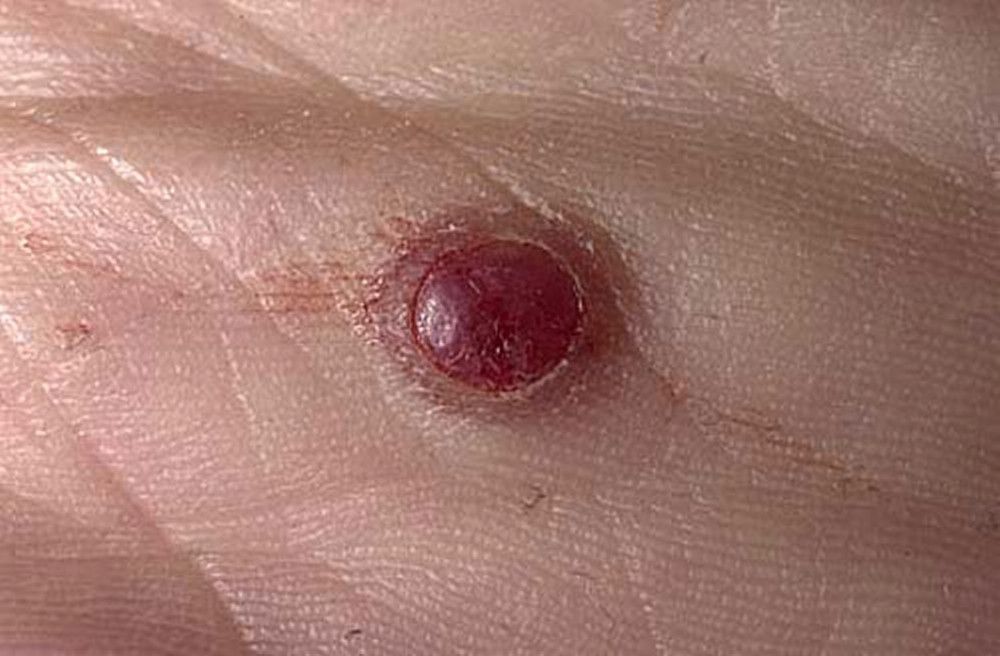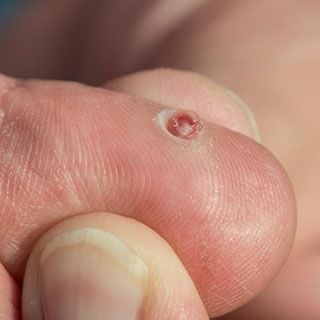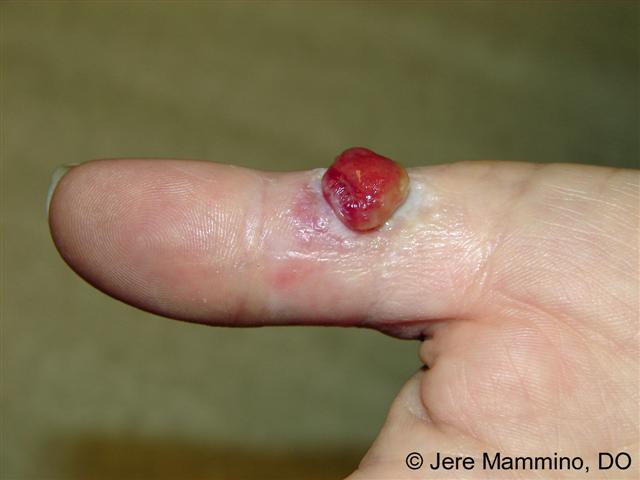Pyogenic granuloma is a common, benign skin growth often appearing as a small, red, and tender bump. It typically results from minor injuries or irritations.
Pyogenic granulomas are vascular lesions that can develop on both mucous membranes and the skin, prominently featuring a rapid growth phase followed by stability. Despite their unsightly appearance, they pose no cancer risk. Commonly occurring in children and young adults, these growths frequently emerge on the hands, fingers, arms, and face, but they can appear anywhere on the body.
Treatment options vary from topical medications to surgical removal, depending on factors such as size, location, and potential for recurrence. With proper management, pyogenic granulomas can be effectively removed, though they do carry a risk for regrowth or leaving behind minor scarring.

Credit: www.merckmanuals.com
Introduction To Pyogenic Granuloma
Pyogenic Granuloma sounds like a complex term. Yet, it is a common skin condition. Let’s dive into what it really is and its significance.
Definition And Overview
A Pyogenic Granuloma is a growth on the skin. This small, reddish bump can bleed easily. It might look alarming, but it’s usually not harmful. The term ‘pyogenic’ suggests pus-producing, but there’s no actual pus in these lesions.
Historical Background
The term “Pyogenic Granuloma” first appeared over a century ago. Two scientists named Poncet and Dor in 1897 originally described this condition. They used the term to describe a botryomycotic, nodule-like lesion.
Prevalence And Importance
Pyogenic Granulomas are quite common. They often affect children and young adults. Pregnant women might notice them more. Quick growth and easy bleeding make this condition significant. It can be mistaken for other skin issues, so accurate diagnosis is crucial.

Credit: www.idermandmohs.com
Etiology Of Pyogenic Granuloma
Pyogenic granuloma is a common skin condition. It presents as a shiny red lump with a rapid growth phase. Understanding its causes is crucial for effective management.
Causal Factors
Causal factors of pyogenic granuloma are still under research. These factors include:
- Minor skin injuries that break the skin surface
- Infections that may contribute to the lesion
- Drugs, such as some types of oral contraceptives or retinoids
Role Of Trauma And Injury
Skin trauma plays a big role in triggering pyogenic granuloma. Here are key points:
- Accidental injuries can promote the growth of these nodules.
- Surgical wounds might also be a starting point for their development.
- Even small scratches or bug bites have potential to lead to pyogenic granuloma.
Hormonal Influences
Fluctuating hormone levels can influence the development of pyogenic granuloma. Significant times include:
- Pregnancy due to the surge in hormones
- Puberty may also see a rise in lesion occurrence
- Medications that affect hormone levels can be contributing factors.
Pathophysiology Of Pyogenic Granuloma
Understanding the pathophysiology of Pyogenic Granuloma helps in unraveling the reasons why these bright red skin bumps appear. This rare, non-cancerous growth can puzzle many with its sudden emergence and often bleed-prone nature. Let’s dive into what goes on beneath the skin’s surface.
Cellular And Molecular Basis
Pyogenic Granuloma stems from a cellular response involving various skin cells. At the molecular level, disruptions in wound healing processes trigger an abnormal response. The cells multiply quickly, creating a small, red lesion on the skin.
- High proliferation of endothelial cells
- Release of growth factors
- Interaction with extracellular matrix components
Angiogenesis And Vascular Proliferation
At the heart of a Pyogenic Granuloma is angiogenesis. This means new blood vessels form from pre-existing ones. With this lesion, excessive angiogenesis leads to a sprout of tiny blood vessels, giving it a reddish appearance. Vascular proliferation explains the growth’s tendency to bleed easily upon minor injury.
| Feature | Description |
|---|---|
| Growth Factors Involved | VEGF, bFGF |
| Characteristic | Rapid Blood Vessel Formation |
Inflammatory Response In Skin Lesions
Strong inflammatory signals accompany the lesions of Pyogenic Granuloma. These signals summon immune cells to the area. The immune cells attempt to heal the lesion, but instead contribute to its growth.
- Migration of immune cells to the lesion
- Release of pro-inflammatory cytokines
- Contribution to lesion growth and maintenance

Credit: www.aocd.org
Clinical Presentation Of Pyogenic Granuloma
A pyogenic granuloma is a common skin growth. It can look alarming because it can grow quickly, bleed easily, and it has a vivid red color. It is often found to appear after an injury and is made up of small blood vessels. Let’s delve into the details of its clinical presentation.
Typical Symptoms
- Rapid growth: It may pop up and grow quickly.
- Bleeding: The lesions can bleed with little or no injury.
- Tenderness: Area may be sensitive to touch.
Physical Appearance And Characteristics
Colorful and shiny, pyogenic granuloma starts off as a lesion that may look like a small red bump. Over time, it may develop a rough surface and can become either dark red or even purplish in color.
Common Sites Of Occurrence
| Body Part | Frequency |
|---|---|
| Fingers | Common |
| Toes | Less Common |
| Face | Occasional |
| Neck | Rare |
Diagnosis Of Pyogenic Granuloma
The identification of Pyogenic Granuloma is a crucial step in providing the correct treatment. This benign vascular tumor can appear deceptively simple but requires careful examination. A precise diagnosis distinguishes it from other skin conditions. It ensures patients receive targeted care for their symptoms.
Clinical Assessment And Differential Diagnosis
Medical experts closely examine the skin to identify Pyogenic Granuloma. They look at its size, shape, and color. The growth typically emerges as a small red bump and can bleed easily. This assessment helps clinicians rule out other possibilities such as:
- Malignant tumors, which require different treatment
- Infected wounds or insect bites that might mimic the appearance
- Vascular anomalies, which may look similar
Doctors also explore the patient’s history. This includes recent injuries, medication use, or changes in health.
Role Of Biopsy
A biopsy is key for a definitive diagnosis of Pyogenic Granuloma. During this procedure, a small tissue sample is removed and examined under a microscope. This method clarifies whether the lesion is benign. It can also rule out other conditions like skin cancers.
Imaging Techniques
In cases where the diagnosis is uncertain, imaging may be used. This helps to provide a clearer picture of the granuloma. Doctors might use:
| Imaging Technique | Purpose |
|---|---|
| Ultrasound | To view the lesion’s structure |
| MRI | To see if the growth has spread deeper |
Imaging is not always needed but can aid in complex cases. It ensures accurate diagnosis and informs the treatment plan.
Management Of Pyogenic Granuloma
Managing Pyogenic Granuloma begins with understanding its nature. This benign vascular tumor can appear suddenly and grow quickly. Although not cancerous, treatment may be necessary. Possible bleedings or cosmetic concerns drive treatment choices. The management strategy might involve conservative treatments, surgical interventions, or exploring emerging therapies.
Conservative Treatments
Conservative options are often the first line of treatment. They offer a non-invasive approach. These might include:
- Topical medications to reduce lesion size
- Oral beta-blockers in small doses
- Silver nitrate for cauterization
These minimally invasive treatments help in controlling the growth of the granuloma.
Surgical Interventions
When conservative treatments don’t suffice, surgical removal becomes necessary. Methods include:
- Excision with a scalpel – cutting out the lesion
- Electrocautery – burning it away
- Laser therapy – using light to remove it
- Cryotherapy – freezing the granuloma
Surgery aims to completely remove the granuloma. It prevents recurrence.
Emerging Therapies
Medical research continues to discover new treatments. Studies are currently examining:
- Immunomodulatory drugs
- Targeted chemical compounds
- Advanced laser innovations
These novel approaches show promise in treating Pyogenic Granuloma. They aim to improve outcomes and reduce side effects.
Conclusion
Understanding pyogenic granuloma is crucial for effective management and treatment. By recognizing this benign skin condition, you can tackle it promptly. Remember, consulting with healthcare professionals is your best strategy for proper care. Our ongoing conversation is key to demystifying such medical issues.
Share your stories and stay informed for healthier skin.

